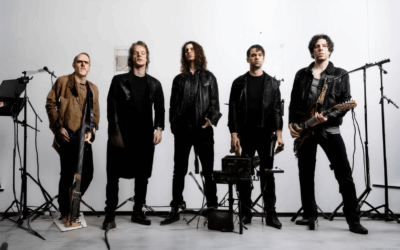In today’s competitive music landscape, standing out as an artist requires more than just talent—it demands a strategic approach to how you present yourself. One of the most crucial tools for musicians is the development of a well-crafted music press kit. This essential document serves as a comprehensive introduction to your artistry, offering potential media outlets, promoters, and fans a detailed overview of who you are, what you do, and why they should care. Whether you’re an emerging artist or a seasoned performer, creating an effective press kit is not just about showcasing your music—it’s about establishing credibility and capturing the attention of your target audience. In this ultimate guide, we’ll walk you through the ins and outs of developing a music press kit, ensuring you’re equipped with the knowledge to create a press kit that truly reflects your artistic vision and enhances your career prospects.
Key Takeaways
– Understand the Purpose: An EPK is a digital portfolio showcasing your artistic identity, including music, bio, and career highlights.
– Choose the Right Tools: Utilize design software like Canva or Adobe InDesign, or opt for free tools like Inkscape.
– Prepare High-Quality Content: Include a detailed bio, photography, and tour dates to enhance your EPK.
– Optimize for SEO: Use keywords like “EPK” and “music press kit” to improve search engine visibility.
– Seek Feedback and Promote: Get peer reviews and share your EPK via email or social media for broader reach.
- Structure Matters: A good EPK includes sections like About, Music, Shows, Discography, Press, Contact, and External Links.
- Embed Multimedia: Add high-quality audio and visuals to showcase your work effectively.
- Use Meta Descriptions: Enhance SEO by adding meta descriptions for better search engine rankings.
- Budget Considerations: Costs range from $100 for basic EPKs to $1,200 for premium versions, depending on content and design needs.

How to Create a Press Kit for Music
A well-crafted press kit is essential for showcasing your music project to journalists, bloggers, and media outlets. Here’s a step-by-step guide to building an effective press kit:
1. Band Bio
Include a concise yet detailed biography of your music project. Highlight your genre, unique sound, and key milestones. Mention significant achievements, awards, or notable performances.
2. Discography
Listing your discography helps provide context and accessibility for listeners. Include albums, EPs, singles, and notable tracks. Attach links to streaming platforms for easy access:
- Albums: “Album Title 1” (Year), “Album Title 2” (Year)
- Singles/EPs: “Single Title 1” (Year), “EP Title” (Year)
- Notable Tracks: “Track Title 1”, “Track Title 2”
Listen to our music on SoundCloud
3. Press Releases
Announce major news such as new releases, tours, or collaborations. Each release should have a clear headline, date, and location:
- Headline: “Breaking News: Your Band Announces New Album Release”
- Date: [Month Day, Year]
- Location: [City, Country] or Virtual Launch Details
- Body: Detailed description of the event or announcement
4. Media Kit
Included in your press kit, this section offers press photos, videos, and bio images. Specify availability and file formats:
For images and videos, please contact us for high-resolution files in JPG/PNG format.
5. Tour Dates & Schedule
Provide a list of past and upcoming tours, including cities, venues, and dates. Link to ticket information:
- Past Tours: “Tour Name 1” (Year), “Tour Name 2” (Year)
- Upcoming Tour: “Tour Name 3” (Date Range), “City Name”
- Buy Tickets
6. Contact Information
Include key contacts for PR, Management, and Booking Agents:
- Public Relations Manager: [Name], [Email], [Phone]
- Management: [Name], [Email], [Phone]
- Booking Agent: [Name], [Email], [Phone]
7. Press Kit PDF Download
Offer a downloadable version of your press kit for easy access. Include all sections in a clean, organized PDF document:
Download Our Press Kit
8. Testimonials & Quotes
Include quotes from critics or fans to add credibility. Cite sources appropriately:
- “Your Band Is A Game-Changer” – [Source Name]
- “Their Music Resonates Deeply” – [Source Name]
9. Embeddable Content
Provide embeddable content for easy sharing, such as YouTube videos or SoundCloud tracks:
Stream Our Latest Track
10. Branding & Tone
Maintain consistency in branding and tone, reflecting your band’s personality. Ensure all visuals and content align with your brand identity.
Organize Your Press Kit
Use clear headings and sections to make your press kit easy to navigate. Combine headings with lists for a clean layout. Ensure all links are functional and follow SEO best practices. Avoid excessive linking and maintain natural flow.
By following these steps, your press kit will be comprehensive, engaging, and optimized for SEO, helping your music project gain visibility and credibility in the media landscape.
What Should an Artist Press Kit Include?
An artist press kit is a crucial tool for artists to showcase their work, connect with media, and promote their career. Below is a detailed breakdown of what should be included:
About Us
- Artist Bio: A brief description of who you are, your artistic style, and your unique vision.
- Professional Background: Details about your training, experience, and notable achievements.
- Press Releases: Official statements about new projects, tours, or significant milestones.
- Media Coverage: Clippings, interviews, and features from reputable sources.
- Social Media Links: Links to your official profiles on platforms like Instagram, Twitter, and Facebook.
Discography
- Albums: List of your full-length albums with release dates and key tracks.
- EPs and Singles: Details about extended plays and singles, including track listings.
- Live Performances: Information about live recordings or performances.
- Collaborations: List of collaborations with other artists or bands.
- Links to Music Platforms: Outbound links to where your music can be streamed or purchased.
Media Assets
- High-Resolution Images: Professional photos, album covers, and artwork.
- Video Clips: Official music videos, live performances, and behind-the-scenes content.
- Audio Samples: Snippets of your music for playback purposes.
- Press Kit PDF: A downloadable version of the press kit for easy distribution.
- Links to Streaming Platforms: Links to platforms where your music is available for streaming.
Tour Dates and Events
- Upcoming Shows: Schedule of live performances, including dates, venues, and ticket information.
- Past Tours: Recap of previous performances and highlights.
- Festivals and Events: Participation in notable events or festivals.
- Links to Ticketing Platforms: Where fans can purchase tickets for upcoming shows.
Press and Bookings
- Publicist Information: Contact details for your public relations team or representative.
- Booking Agent: Name and contact information for your booking agent.
- Press Inquiries: Instructions on how media can contact you for interviews or features.
- Links to Management Websites: Outbound links to your management company’s website.
Contact Information
- Email Address: Fan contact email for inquiries.
- Mailing Address: Physical address for fan mail or promotional materials.
- Phone Number: Office phone number for bookings or press inquiries.
- Social Media Handles: Links to your social media profiles for direct engagement.
Additional Resources
- Blog Posts: Articles, news, and updates from your official blog.
- FAQs: Common questions about your music, tours, and career.
- Tips for Emerging Artists: Guidance on building your career and growing your fanbase.
- Links to Resources: Outbound links to helpful websites and tools for artists.
By including all these elements, your press kit will be comprehensive, professional, and ready to assist journalists, promoters, and fans in learning more about your artistry and career.

How to Create a Press Kit
A press kit is a collection of materials designed to provide journalists and media outlets with information about your company, product, or event. Below is a guide on how to create an effective press kit:
1. Company Overview
- Company Name: Include the full legal name of your company.
- Location: List the headquarters and office locations.
- Mission Statement: A brief statement outlining your company’s purpose and goals.
- Tagline: A catchy phrase that sums up your company’s essence.
2. Who We Are
- Founding Team/Bios: Introduce key team members with their roles and backgrounds.
- Leadership Team: Highlight executives and their contributions.
- Photography: Include headshots and team photos for media use.
3. What We Do
- Products/Services: Detail your offerings with descriptions and images.
- Unique Selling Points (USPs): Identify what sets you apart from competitors.
- Press Releases: Include a template for issuing news.
4. Frequently Asked Questions (FAQs)
- About Us
- Our Products/Services
- Team Information
- Future Plans
5. Media Kit
- High-Resolution Images: Include logos, product images, and team photos.
- Logo Usage Guidelines: Provide rules for using your logo.
- Downloadable Assets: Offer PDFs, videos, and other digital assets.
6. Distribution
- Distribute via PR Agencies
- Online Platforms
- Press Release Distribution Services
7. Final Touches
- Proofread for Errors
- Update Content Regularly
- Include Contact Information
- Offer Physical Copies Upon Request
By following these steps, you can create a comprehensive and professional press kit that effectively communicates your brand’s story to the media.

How to Create Your Own EPK
To create a compelling EPK, follow these organized steps:
- Understand the Purpose : An EPK serves as a digital portfolio showcasing your artistic identity, including your music, bio, and career highlights.
- Choose the Right Tools :
- Design Software : Use tools like Canva, Adobe InDesign, or Wix for professional designs. Consider free options like Inkscape for cost-effective solutions.
- Host Platforms : Upload your EPK to platforms like Bandcamp, SoundCloud, or Reverbnation for distribution.
- Content Preparation :
- Bio Section : Include a detailed artist bio covering history, discography, and notable achievements. Mention tour dates and significant events.
- Photography : Add high-quality images, including live performances or behind-the-scenes videos to enhance engagement.
- Design and Layout :
- Use professional-grade tools for a polished look. Ensure the design is consistent with your brand, using colors and fonts that reflect your style.
- Distribution Strategy :
- Share via email or social media links. Password-protect files if necessary to control access.
- SEO Optimization :
- Optimize metadata and titles with relevant keywords to improve search engine ranking.
- Feedback and Promotion :
- Seek peer reviews to refine your EPK. Promote it through your social channels and collaborate with influencers for wider reach.
By following these steps, you can create a professional and effective EPK tailored to your needs.
What Does a Good EPK Look Like?
An effective EPK (Electronic Press Kit) serves as a comprehensive digital resource that showcases a band or artist’s identity, career highlights, and promotional content. Below is a breakdown of what makes a well-crafted EPK stand out:
1. Clear Structure
A well-organized EPK typically includes the following sections:
About
- A brief band or artist bio.
- Mission statement and unique selling points.
Music
- High-quality audio samples or embeds.
- Notable tracks and album information.
- Genres and musical style overview.
Shows
- Tour dates and live performances.
- Venue details and ticket information.
- Upcoming events and past performances.
Discography
- Full discography listing.
- Album artwork and release dates.
- Track listings and special editions.
Press
- Press releases and media coverage.
- Critical acclaim and awards.
- Links to professional reviews and features.
Contact
- Publicist and manager contact info.
- Social media handles and fan engagement tools.
- Booking inquiries and merchandise links.
External Links
- Official website: Oedipus Band
- Social media profiles: Twitter , Facebook
- Music streaming platforms: Spotify
SEO Best Practices
- Include a meta description tag at the end for SEO purposes.
- Use keywords like “EPK,” “Electronic Press Kit,” and “band promotion” naturally throughout the content.
- Optimize image filenames and alt texts for better accessibility and SEO.
By combining these elements, an EPK becomes a valuable tool for media, promoters, and fans to discover and engage with the band or artist effectively.

How Much Does It Cost to Make an EPK?
The cost of creating an Electronic Press Kit (EPK) varies based on several factors, including the scope of the project, design requirements, and content creation. Here’s a breakdown of the typical pricing tiers based on current market rates:
- Bronze Tier
- Price Range: $100 – $300
- Includes basic setup with essential content such as a band bio, press release, and a few high-resolution images. This tier is ideal for artists or bands looking for a simple, functional EPK without extra frills.
- Silver Tier
- Price Range: $300 – $700
- Offers a more comprehensive EPK with expanded content, including a detailed discography, tour dates, and embedded audio/visual content. The design may include basic animations and responsive layout optimization for various platforms.
- Gold Tier
- Price Range: $500 – $1,200
- Provides the most extensive EPK solution, featuring premium content such as original writing, high-quality photography, and video production. Advanced design elements like interactive features and seamless integration with social media platforms are included.
Conclusion: The total cost to create an EPK typically falls between $100 and $1,200, depending on the level of detail, design complexity, and additional features required. Artists should evaluate their needs and budget accordingly to choose the most suitable tier for their goals.



0 Comments